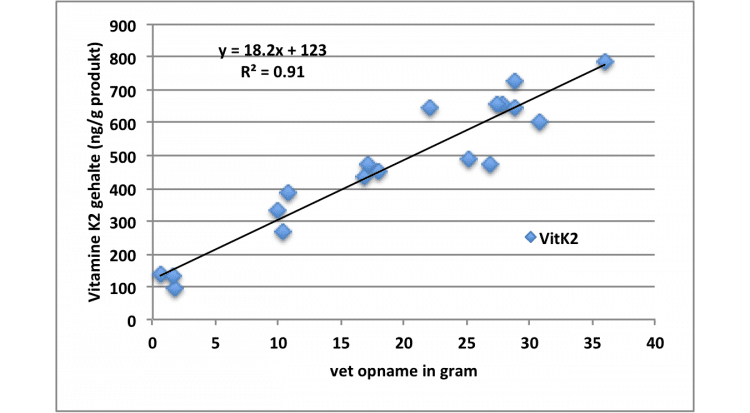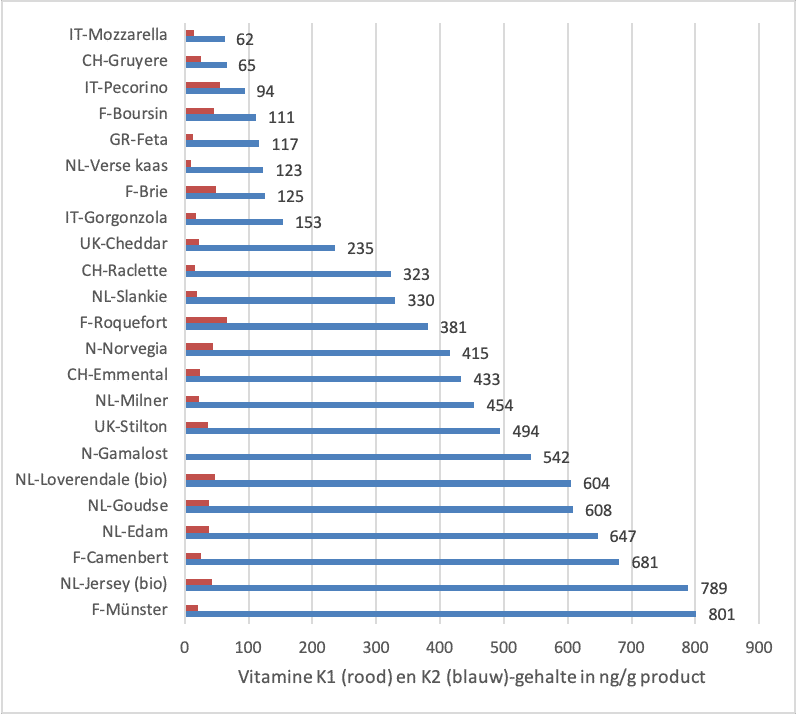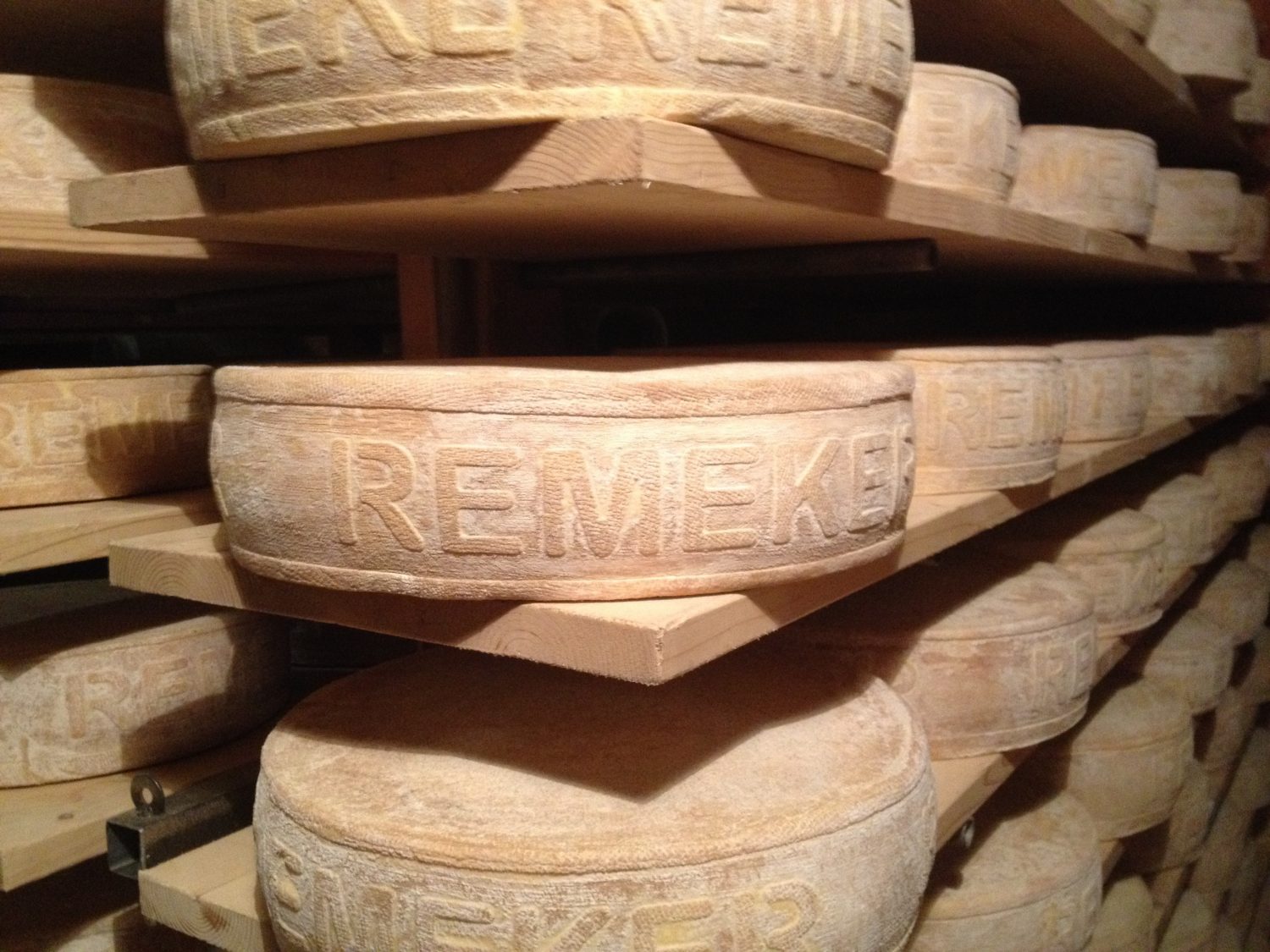This statement applies at least to the intake of milk fat-bound substances, such as the fat-soluble vitamins A, D, E and K. The University of Maastricht has measured the amounts of vitamin K1 and K2 in various cheeses consumed in The Netherlands (Vermeer et al., 2018; Halder et al., 2019; Akbulut et al., 2020). Cheese can be classified, among other, according to age, type of ripening and dry matter fat content. Cream cheeses such as cottage cheese are usually ready to be directly consumed within one week of production. Young Gouda cheese matures in 2-4 weeks. Industrial Gouda cheese made in creameries is standardized to 48% fat in dry matter. With increasing age of the cheese, the moisture content decreases and the fat content in the product increases. Artisanal farmhouse cheese made on a single farm is not standardized and therefore contains more fat, depending in part on the breed of the cows. For the fattest bite, eat old farmhouse cheese made from Jersey cow milk.
The combination of standardization (% milk fat in the dry matter), maturation (moisture content), farmhouse cheese versus industrial cheese leads to large differences in the amount of milk fat per weight of cheese. In Figure 1, the X-axis shows the amount of fat per kg of cheese. There is a strong correlation between fat content and vitamin K2 content, since K2 is bound to fat. When you ingest more milk fat through a cheese, your vitamin K2 intake will increase. The uptake of K2 increase, and there is about 18 ng K2 per gram fat (Fig. 1). There are no real plant-based alternatives for vitamin K2, except for Natto (fermented soybeans from Japan). Vitamin K2 comes mainly from animal and fermented products such as cheese. The lactic acid bacteria in cheese play an important role in the building of vitamin K2. The ripening of cheese can be caused by bacteria or fungi. Blue molds like Roquefort, for example, are mixed into the cheese curd to grow inside the ripening curd. The type of bacteria and molds also affects the final K2-content.
Starter cultures for cheese can be mesophilic (25-35oC) or thermopylic (up till 55oC). Gouda, Tilsiter, and Cheddar are based on mesophilic starters, whereas Gruyere, Emmentahl and mountain cheeses use thermophilic starters. Mesophylic starters produce much more K2 compared to thermopylic cultures.

Figure 1. The relationship between the amount of fat intake from a dairy product and the total amount of vitamin K2 in the product (data from Vermeer et al., 2018).
If you compare types of cheese from different regions of production, you will notice that there are major differences between cheese types (Fig. 2). This is due to the moisture content (the less, the more fat) and thus to the maturation time, the type of starter culture (mesophilic starters produce different amounts of K2), the breed of the cows (Jersey milk is very fat, as well as the cheese made from it). It is noticeable that the Gouda-like types of cheese get a high score due to the mesophilic starter cultures used. There is, however, a big difference between the two white mold cheeses (Brie scores low, Camembert high). The K2 content in Swiss Gruyere is remarkably low for a mature cheese due to the thermophilic bacterial culture used.

Figure 2. Country of origin, cheese type and content of vitamin K1 (red) and K2 (blue) per gram of product (ng/g of product).
Vitamin K2 is important in terms of reducing cardiovascular disease (reducing deposits in the coronary arteries) and fighting osteoporosis (sufficient calcium deposits in the bones). In popular terms: K2 stimulates the maintenance of soft vessels and builds hard bones.
The numerical information is mainly based on the data from Vermeer et al. (2018). The graphics are derived from the data in the article.
Literature
- Akbulut, A. C., Pavlic, A., Petsophonsakul, P., Halder, M., Maresz, K., Kramann, R., & Schurgers, L. (2020). Vitamin K2 needs an RDI separate from vitamin K1. Nutrients, 12(6), 1852.
- Halder, M., Petsophonsakul, P., Akbulut, A. C., Pavlic, A., Bohan, F., Anderson, E., … & Schurgers, L. (2019). Vitamin K: double bonds beyond coagulation insights into differences between vitamin K1 and K2 in health and disease. International journal of molecular sciences, 20(4), 896.
- Vermeer, C., Raes, J., Van’t Hoofd, C., Knapen, M. H., & Xanthoulea, S. (2018). Menaquinone content of cheese. Nutrients, 10(4), 446.




